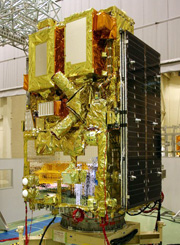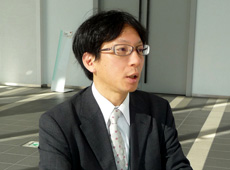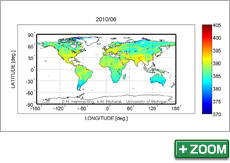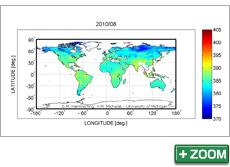Q. How is IBUKI involved in data standardization for the GEO Carbon Project?

Greenhouse Gases Observing Satellite IBUKI
I think that standardization means providing data in a user-friendly unified format, but in the case of IBUKI this is still a work in progress. At the moment we are coordinating things with GEO-related space agencies and organizations.
When satellites such as IBUKI measure greenhouse gases from space, they can observe gas concentration in the entire three-dimensional area that the sensor’s light travels through. Observations from the ground, however, are often more localized. Sometimes gas concentrations are measured using sensors mounted on towers - for instance, 10 meters or 50 meters from the ground. But there are many kinds of observation tools, and other ground-based observation methods do allow us to measure the entire area that the observation waves go through, just like observation from space.
Because there are so many different observation methods, there are differences between observation data from satellites and from the ground. In order to make IBUKI’s observation data more reliable, our challenge in the data standardization process is to correct for those differences.
Additionally, we need to compare data with other satellites, as well as ground observations. Several satellites have greenhouse gas observation sensors similar to IBUKI’s: the European Space Agency’s Envisat and MetOp, etc. We are thinking of cooperating with the Centre National d’Études Spatiales (CNES), which developed the sensor for MetOp, to cross-validate our data. Furthermore, NASA is scheduled to launch the Orbiting Carbon Observatory OCO-2 in February 2013, so we are hoping for a successful launch this time, and cooperation with IBUKI on data standardization.
Q. How do you want to expand the utility of the carbon data from IBUKI?

Greenhouse Gases Observing Satellite IBUKI

We would like to use the data from IBUKI not only from a scientific viewpoint with respect to measuring the increase and decrease of carbon dioxide, but also from the viewpoint of social contribution. In particular, we would like to contribute to the efforts of UN-REDD-Plus, under the United Nations Framework Convention on Climate Change (UNFCCC). The original UN-REDD program aimed to reduce carbon emissions that result from the disappearance and degradation of forests. The "Plus" reflects a new goal - to increase forest cover by planting new trees.
Forests absorb carbon dioxide in the atmosphere, but due to the gradual reduction of tree cover caused by illegal logging and global warming, and loss of forests from fires, the amount of carbon dioxide absorption has decreased. As a result, the concentration of carbon dioxide in the atmosphere has increased. So the goal of UN-REDD-Plus is to prevent forest degradation and decrease the concentration of carbon dioxide in the atmosphere through the planting of trees.
JAXA’s Advanced Land Observing Satellite DAICHI is already providing data on changes in forested area for UN-REDD-Plus. We would like to contribute to the program through IBUKI as well by providing data on changes in the concentration of carbon dioxide. Q. Can you tell us about your future ambitions? In the future, we would like to be able to measure the amount of each country’s carbon dioxide emissions. With this in mind, there are some aspects where we are not satisfied with the accuracy of IBUKI’s observation sensor. I think we need to launch successors to IBUKI in order to develop more accurate observation devices.
However, just providing satellite data is not enough. To obtain more-reliable data, we need to combine it with ground observation data while correcting for the discrepancies. To accomplish this goal, cooperation with organizations that have ground observation data is essential. We would like to increase data accuracy while cooperating with related organizations, so that we are not seen as just a data provider.
Additionally, global warming issues are common throughout the world. Observations from space are very effective, so we hope to start providing highly accurate data on carbon dioxide absorption/emissions to countries that don’t have their own observation capabilities.
Masakatsu Nakajima
Mission Manager, Satellite Applications and Promotion Center, JAXA Space Application Mission Directorate
Mr. Nakajima graduated from Nagoya University in 1985. He has been working in Earth-observation research since starting work on optical sensors in 1987. Mr. Nakajima worked on the development of the Global Imager (GLI) aboard the Advanced Earth Observing Satellite MIDORI-II.
Researching the Carbon Dioxide Cycle
World’s First High-Resolution Global Forest/Non-Forest Map
Japan Contributes to Efforts to Solve Environmental Problems
Policymakers Worldwide Need Unified Carbon Cycle Data
Reliable Data Essential for Greenhouse Gas Reduction



